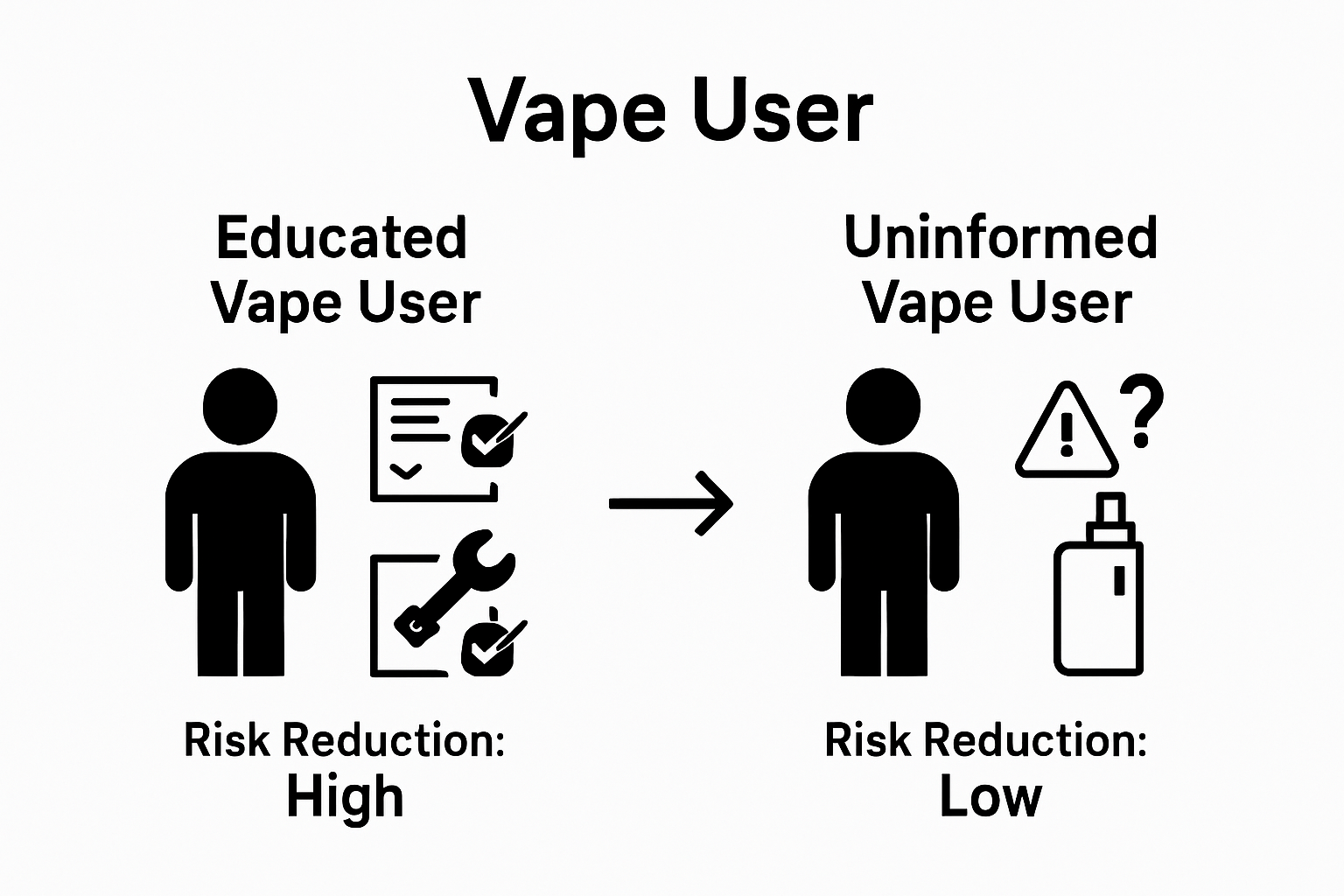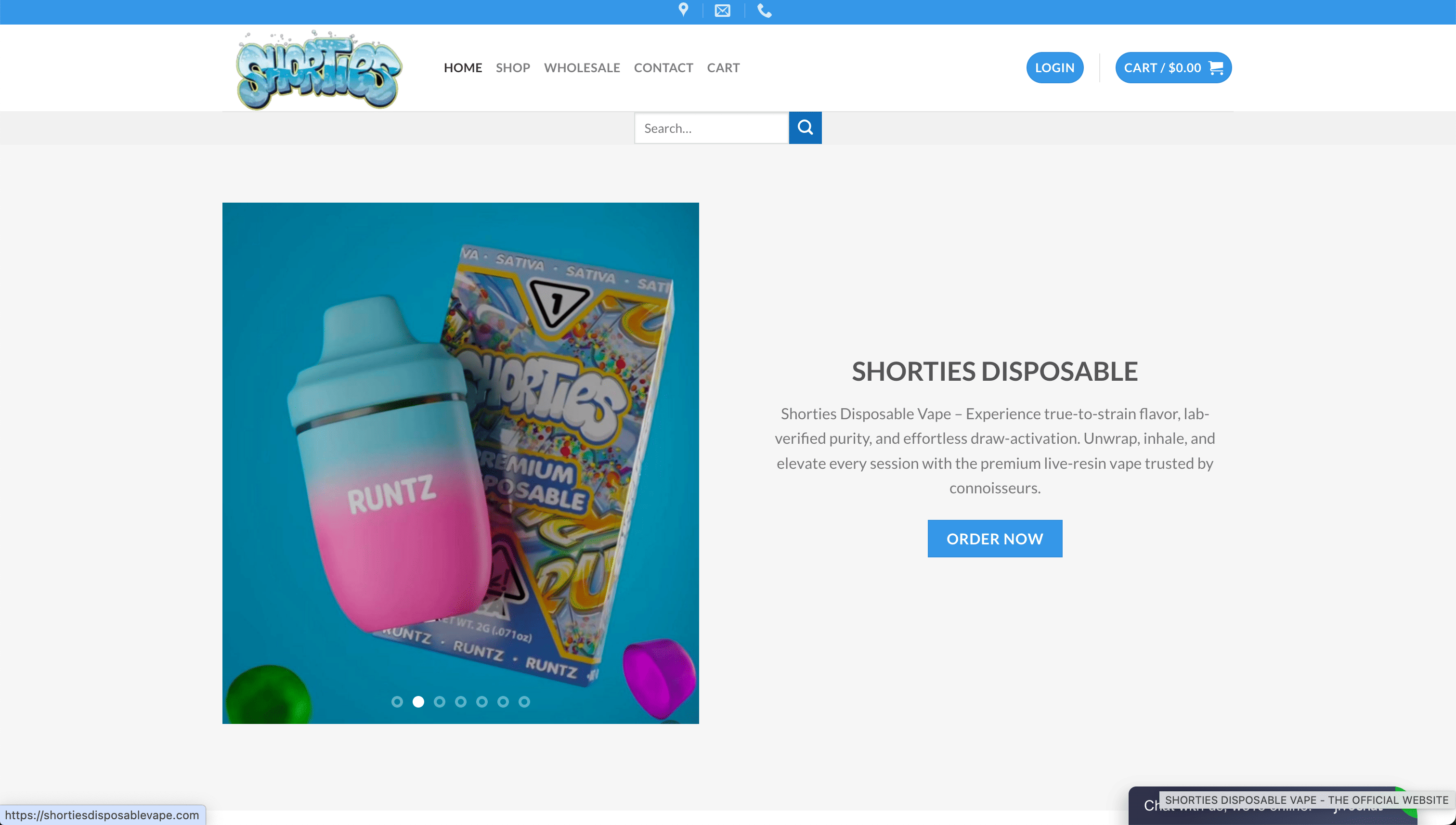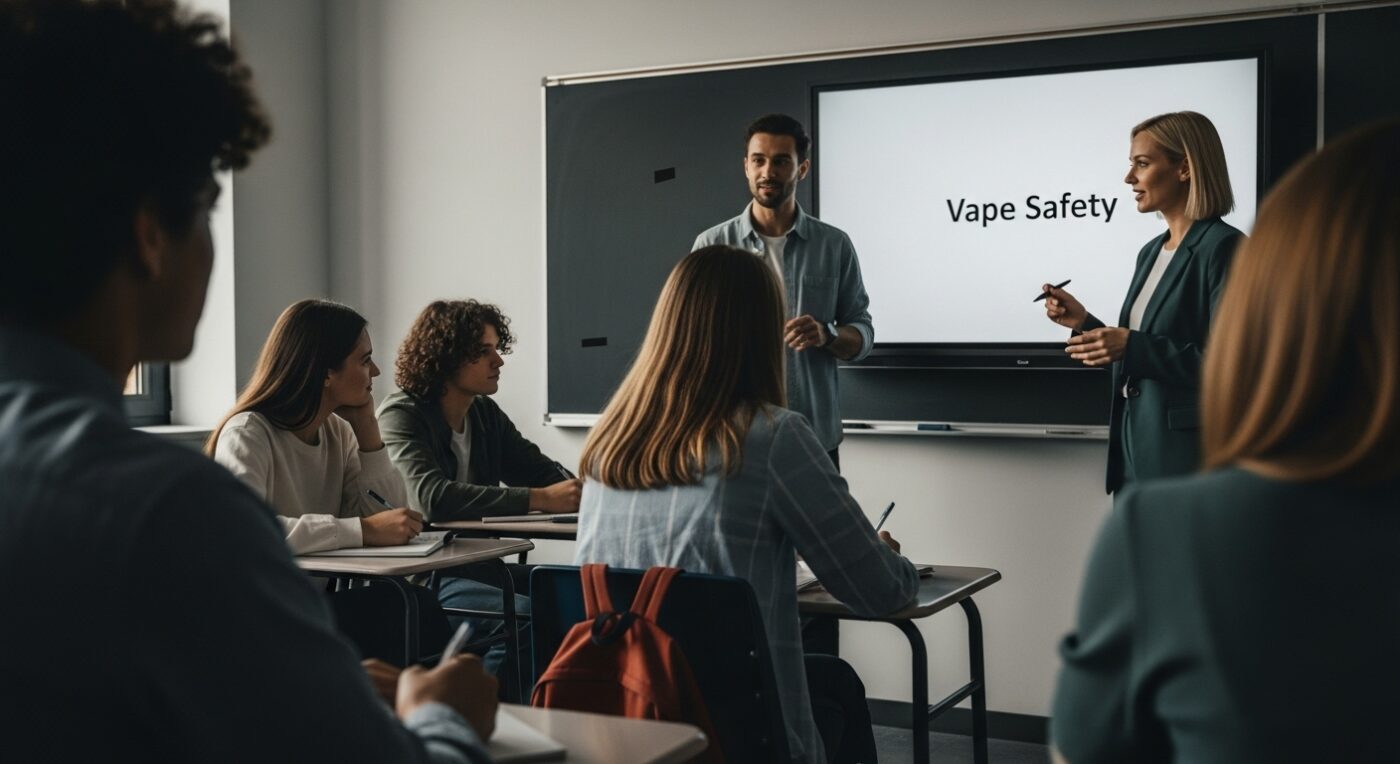Blog
Understanding the Role of Education in Vape Safety
Vape safety is more than just a cautionary label on a device. Up to 85 percent of e-cigarette devices and pods in retail outlets are potentially illegal products according to U.S. health officials. Many people assume all vaporizers on store shelves meet strict standards but the reality is most do not. The real key to staying safe isn’t just picking a popular brand, it starts with understanding what’s inside the device and how knowledge protects you where loose regulations often cannot.
Table of Contents
- What Is Vape Safety And Why It Matters
- The Importance Of Education In Reducing Risks
- How Education Influences Vape Product Choices
- Understanding Regulations And Compliance In Vaping
- Key Concepts For Safe Vaping Practices
Quick Summary
| Takeaway | Explanation |
|---|---|
| Understand vape risk factors | Identify chemical contaminants and device malfunctions that impact health. |
| Prioritize education on vaping | Knowledge equips consumers to make informed choices about vaping devices and substances. |
| Recognize regulations and compliance | Familiarize yourself with safety guidelines that ensure product quality and user protection. |
| Practice personal responsibility | Be aware of individual health conditions and maintain devices for safe usage. |
| Make informed product selections | Evaluate products based on technical specifications and safety standards to avoid impulsive purchases. |
What is Vape Safety and Why It Matters
Vape safety represents a comprehensive approach to minimizing risks associated with cannabis and nicotine vaporization technologies. At its core, this concept encompasses understanding potential health hazards, proper device handling, and informed usage practices that protect consumers from potential harm.
Understanding the Fundamental Risks
Vape safety begins with recognizing the potential dangers inherent in vaporization technologies. These risks include exposure to harmful chemical compounds, potential device malfunctions, and long-term health implications. Proper education is crucial in mitigating these risks. Understanding the composition of vaping materials, recognizing quality manufacturing standards, and knowing how to identify safe products are foundational elements of responsible vaping.
Key risk factors include:
- Potential chemical contaminants in vaping liquids
- Battery and device malfunction risks
- Improper storage and handling of vaping equipment
- Unregulated manufacturing processes
Health and Technological Considerations
The role of education in vape safety cannot be overstated. According to research from the Cureus medical journal, comprehensive public health education strategies are essential in reducing misperceptions and promoting safer vaping behaviors. This involves not just understanding immediate risks, but also comprehending long-term potential health impacts.
Consumers must be equipped with knowledge about:
- Proper device maintenance
- Understanding product specifications
- Recognizing quality certification markers
- Identifying potential manufacturing red flags
Ultimately, vape safety is a multifaceted approach that requires ongoing education, technological awareness, and personal responsibility.
To clarify the distinct yet interconnected dimensions of vape safety, the table below compares key aspects of health risks and technological considerations as discussed in the article.
| Aspect | Health Considerations | Technological Considerations |
|---|---|---|
| Main Focus | Chemical exposure, physiological impacts | Device mechanics, battery safety, product standards |
| Key Risks | Potential contaminants, long-term health effects | Device malfunctions, quality control, faulty components |
| Role of Education | Helps identify safe substances and understand health consequences | Equips users to recognize quality devices and proper maintenance |
| Preventive Actions | Reading ingredient labels, monitoring health symptoms | Following maintenance guidelines, checking for certification markers |
| Importance to Users | Informed health decisions, personal risk awareness | Safer device use, avoidance of unsafe technology |
The Importance of Education in Reducing Risks
Education serves as a critical foundation for mitigating potential hazards associated with vaping technologies. By providing comprehensive information and nuanced understanding, educational strategies empower consumers to make informed decisions about their health and technology usage.
Addressing Knowledge Gaps
Vape safety education targets critical knowledge gaps that often lead to uninformed and potentially dangerous behaviors. Comprehensive educational approaches break down complex information into digestible insights, helping users understand the intricate relationship between vaping technologies, chemical compositions, and potential health implications.
Key knowledge areas that require targeted education include:
- Detailed understanding of chemical interactions
- Precise device technical specifications
- Potential short and long-term physiological impacts
- Recognition of quality manufacturing standards
Behavioral Change Through Informed Understanding
According to research in the International Journal of Environmental Research and Public Health, education-focused interventions play a transformative role in reducing misconceptions and promoting safer practices. These interventions go beyond simple information transmission, actively challenging existing beliefs and encouraging critical thinking about vaping technologies.
Critical educational objectives involve:
- Developing critical analysis skills
- Challenging preexisting misconceptions
- Promoting responsible technology engagement
- Encouraging personal health accountability
Strategic Knowledge Empowerment
Effective educational strategies recognize that risk reduction is not about fear-based messaging, but about providing clear, scientifically grounded information. By equipping users with precise knowledge about device mechanics, chemical interactions, and potential health consequences, education becomes a powerful tool for personal and community safety.
Ultimately, the role of education in vape safety transcends mere information sharing. It represents a holistic approach to empowering individuals with the knowledge, skills, and critical thinking necessary to navigate complex technological landscapes responsibly and safely.
How Education Influences Vape Product Choices
Education plays a transformative role in shaping consumer decision-making within the vaping landscape. By providing comprehensive information about product characteristics, potential risks, and technological nuances, educational initiatives directly impact how individuals select and interact with vaping technologies.
Informed Decision Making Processes
Consumer knowledge serves as the primary mechanism for intelligent product selection. Educational efforts help users move beyond superficial marketing narratives, enabling them to critically evaluate vaping products based on substantive technical specifications, safety standards, and potential health implications. This knowledge transformation shifts purchasing decisions from impulse-driven selections to carefully considered choices.
Key factors influencing educated product selection include:
- Comprehensive understanding of device specifications
- Recognition of quality manufacturing standards
- Awareness of potential health consequences
- Technical comprehension of device mechanics
Knowledge Impact on Consumer Behavior
According to research exploring educational interventions with students, targeted educational programs can dramatically enhance understanding of product risks. Such interventions demonstrate that increased knowledge directly correlates with more discerning product choices, reducing impulsive purchasing behaviors and promoting more responsible technology engagement.
Significant behavioral shifts resulting from education include:
- Enhanced critical analysis skills
- Reduced susceptibility to marketing manipulation
- Increased emphasis on product safety
- More sophisticated technology evaluation
Empowerment Through Understanding
Education fundamentally transforms the consumer relationship with vaping technologies. By providing users with sophisticated analytical tools, educational initiatives empower individuals to navigate complex product landscapes with greater confidence and precision. This approach transcends traditional consumer guidance, creating a more informed, responsible user base capable of making nuanced technological decisions.

Ultimately, education represents more than information transmission. It is a powerful mechanism for reshaping consumer perspectives, challenging existing assumptions, and promoting a more thoughtful, safety-oriented approach to vaping technology selection and usage.
Understanding Regulations and Compliance in Vaping
Regulations and compliance represent critical frameworks designed to ensure consumer safety, product quality, and responsible technological engagement within the vaping ecosystem. These structured guidelines establish comprehensive standards that protect users and promote responsible industry practices.
Legal and Safety Frameworks
Regulatory systems function as essential protective mechanisms for consumers navigating complex vaping technologies. These frameworks encompass manufacturing standards, product testing requirements, marketing restrictions, and age-related access controls. By establishing clear boundaries, regulations aim to mitigate potential health risks and prevent inappropriate technology distribution.
Key regulatory focus areas include:
- Stringent manufacturing quality standards
- Mandatory product safety testing
- Age verification protocols
- Transparent ingredient disclosure
- Marketing limitations targeting youth
Compliance Challenges and Implementations
According to research from the U.S. Department of Health and Human Services, up to 85% of e-cigarette devices and pods sold in retail outlets represent potentially illegal products. This statistic underscores the critical importance of robust regulatory enforcement and comprehensive compliance mechanisms.
Significant compliance challenges involve:
This table organizes common compliance challenges affecting vape product regulations, making it easier to see the key issues manufacturers, retailers, and regulators must address for consumer protection.
| Compliance Challenge | Description | Impact on Vape Safety |
|---|---|---|
| Inconsistent enforcement | Uneven application of laws across regions | Leads to availability of illegal products |
| Rapid technological evolution | Fast-paced changes in device design and content | Regulations often lag behind new products |
| Complex supply chain | Numerous intermediaries in manufacturing and distribution | Greater difficulty tracking product safety |
| Product innovation | New forms and formulations regularly introduced | Increased risk of untested products |
| International regulatory gaps | Differences in standards and enforcement between countries | Enables cross-border circulation of unsafe vapes |
- Inconsistent enforcement across jurisdictions
- Rapid technological evolution
- Complex supply chain management
- Emerging product innovation
- International regulatory disparities
Evolving Regulatory Landscape
Regulatory frameworks continue to adapt in response to technological advancements and emerging health research. These dynamic systems require ongoing collaboration between manufacturers, healthcare professionals, regulatory bodies, and consumer advocacy groups to develop effective, responsive guidelines.
Effective regulation transcends mere restriction. It represents a sophisticated approach to balancing technological innovation, consumer protection, and public health considerations. By establishing clear, scientifically informed standards, regulatory frameworks create environments that promote responsible product development, transparent consumer communication, and comprehensive safety protocols.
Key Concepts for Safe Vaping Practices
Safe vaping practices represent a comprehensive approach to minimizing potential health risks and ensuring responsible technology engagement. By understanding fundamental principles and implementing strategic precautions, users can significantly reduce potential negative consequences associated with vaping technologies.
Foundational Safety Principles
Personal responsibility forms the cornerstone of safe vaping practices. This involves developing a nuanced understanding of device mechanics, chemical interactions, and individual physiological responses. Recognizing that each vaping experience involves complex technological and biological interactions enables users to make more informed, cautious decisions.
Key safety principles include:
- Comprehensive device understanding
- Awareness of personal health conditions
- Regular equipment maintenance
- Responsible storage practices
- Mindful consumption patterns
Educational Intervention Strategies
According to research from the CDC’s Empower Vape-Free Youth campaign, targeted educational interventions play a crucial role in promoting safe technological engagement. These strategies focus on developing critical thinking skills, understanding potential risks, and fostering a proactive approach to personal health management.
Critical educational focus areas involve:
- Recognizing potential health risks
- Understanding chemical composition
- Developing critical analysis skills
- Promoting responsible technology use
- Challenging marketing misconceptions
Technological and Personal Safeguards
Safe vaping transcends simple device operation. It encompasses a holistic approach that integrates technological knowledge, personal health awareness, and responsible consumption practices. Users must develop sophisticated understanding of device specifications, potential interaction risks, and individual physiological responses.
Ultimately, safe vaping practices represent an ongoing commitment to personal health, technological literacy, and responsible consumption. By prioritizing education, critical thinking, and proactive risk management, individuals can navigate the complex landscape of vaping technologies with greater confidence and reduced potential for negative health consequences.

Take Vape Safety From Theory to Practice With Shorties Disposable
Reading about vape safety is just the beginning. If you have ever worried about how to verify product authenticity, trust lab-tested ingredients, or avoid the unknowns of low-quality devices, you are not alone. As highlighted in the article, education is your first line of defense against the risks of chemical contaminants and unregulated products. You deserve more than just knowledge—you deserve real solutions you can trust.

Ready to apply what you have learned and choose vaping options with verified safety? Visit Shorties Disposable Vape for high-capacity, lab-tested cannabis disposables, complete with transparent lab results and easy product authentication. Make the switch today, access in-depth product information, and experience what it means to shop with confidence. Your safety starts with your next click.
Frequently Asked Questions
What are the primary risks associated with vaping?
Vaping risks include exposure to harmful chemical compounds, potential device malfunctions, and long-term health implications. Proper education is crucial to mitigate these risks by understanding vaping materials and identifying safe products.
How does education help in promoting safe vaping practices?
Education helps promote safe vaping practices by empowering consumers with knowledge about device mechanics, chemical interactions, and health impacts. This understanding enables individuals to make informed decisions and adopt responsible usage habits.
What should I look for when choosing a vaping device?
When selecting a vaping device, consider key factors such as device specifications, manufacturing quality standards, safety testing, and potential health consequences. Knowledge of these aspects helps consumers make educated choices and avoid unsafe products.
Why is it important to understand regulatory frameworks in vaping?
Understanding regulatory frameworks in vaping is important as they establish standards for product safety, manufacturing processes, and marketing practices. Awareness of these regulations helps consumers ensure they are using compliant, safe products.

